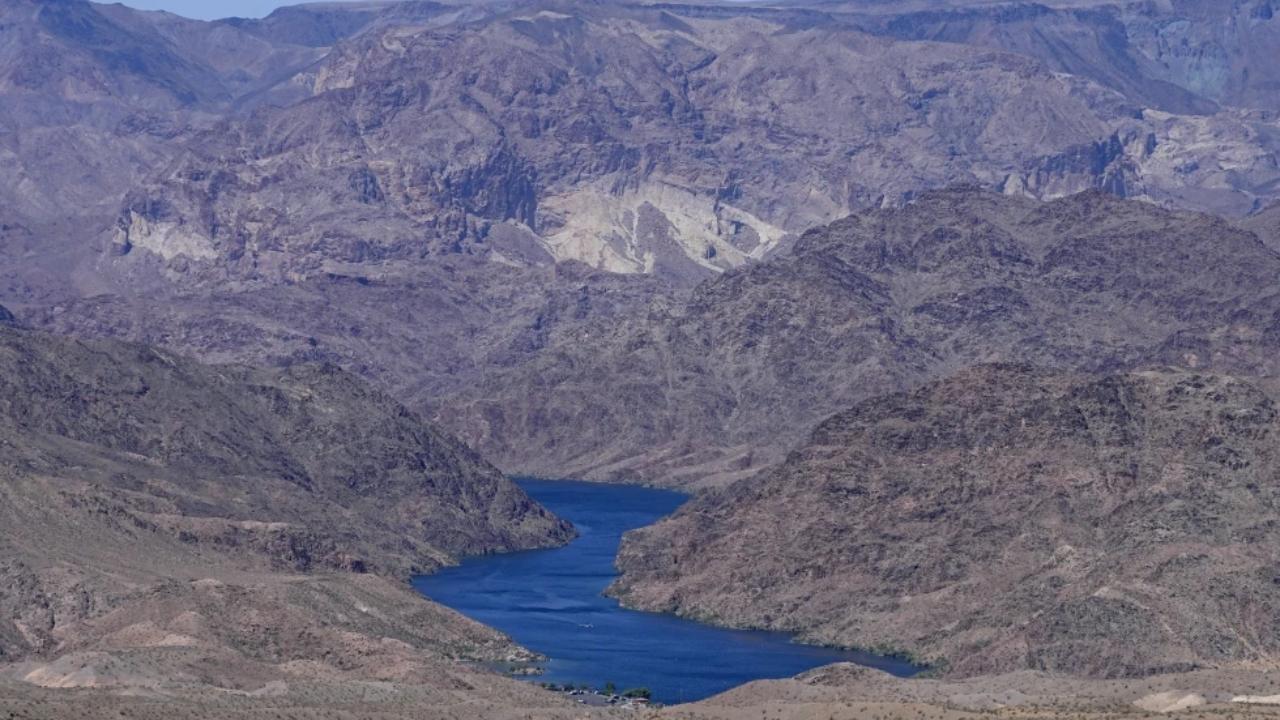
Post by : Monika
Photo: AP
The Colorado River is one of the most important sources of water in the western United States. It provides water for millions of people, farms, cities, and industries across seven U.S. states and even reaches parts of Mexico. The river also supports electricity production through hydroelectric dams and sustains natural habitats for plants and animals.
However, the river is facing serious challenges. Over the years, humans have used more water than the river can safely provide. This overuse, combined with long-lasting droughts and the effects of climate change, has caused water levels in key reservoirs like Lake Mead and Lake Powell to fall to dangerous levels. Scientists and environmental groups warn that if action is not taken, the river could face permanent damage, threatening millions of people and the environment.
To address this problem, several environmental organizations have petitioned the U.S. federal government to take strong action. They want clear rules to ensure water from the Colorado River is used only for “reasonable” and “beneficial” purposes. Their goal is to stop wasteful practices and protect the river for future generations.
Why Protecting the Colorado River Is Important
The Colorado River supplies water for many purposes. It is used for farming, which depends on irrigation to grow crops. It also provides drinking water for cities and towns, and it helps generate electricity in several states.
In recent decades, the demand for water from the Colorado River has increased greatly. More people are living in the western U.S., cities are expanding, and farms continue to grow crops that require a lot of water. At the same time, climate change has caused higher temperatures and longer dry periods, reducing the river’s natural flow.
As a result, reservoirs such as Lake Mead and Lake Powell, which store water for millions of people, have dropped to record-low levels. This is dangerous because it puts pressure on communities, farmers, and ecosystems. Low water levels can also affect electricity production, reduce water quality, and increase conflicts among states and water users.
Experts warn that without stricter rules and better management, the Colorado River may not be able to meet the needs of the people and industries that depend on it.
What Environmental Groups Are Asking For
Environmental organizations are calling on the U.S. Bureau of Reclamation, the federal agency in charge of water management, to clearly define what counts as “reasonable” and “beneficial” water use.
These terms are important because they guide how water is distributed. “Reasonable use” means using water in a way that is necessary and fair, without waste. “Beneficial use” means water is used for purposes that benefit people or the environment, such as drinking water, farming essential crops, or supporting natural habitats.
Without clear definitions, it is difficult to prevent waste or enforce rules. For example, some farming methods that were once considered efficient may now use too much water. Urban areas may also be using water inefficiently, especially in dry regions. By establishing clear standards, the government can help protect the river while still supporting human and environmental needs.
Challenges in Defining Water Use
One of the main challenges is that different groups have different ideas about what is reasonable or beneficial. Farmers, city officials, environmentalists, and recreational users all have different needs and priorities.
For instance, a farmer may want to use large amounts of water for crops, while environmentalists may argue that leaving more water in the river is essential to protect fish and wildlife. Urban developers may want water for landscaping and new housing projects, while scientists may warn that these uses could harm the river system.
This difference in perspective makes it hard to create rules that satisfy everyone. Environmental groups emphasize that outdated policies do not reflect current environmental conditions. With climate change causing hotter temperatures, longer droughts, and less rainfall, water management rules need to be updated to prevent shortages and protect the river ecosystem.
Possible Solutions to Protect the River
Experts and environmentalists suggest several ways to reduce water waste and improve management of the Colorado River:
Improved Irrigation Methods – Farmers can adopt modern irrigation techniques, such as drip irrigation, that deliver water directly to plant roots. This method uses much less water than traditional flooding or sprinkler systems. By making agriculture more efficient, less water is wasted, and more remains for other users.
Water Recycling – Treated wastewater can be reused for activities that do not require drinking-quality water, such as watering gardens, cleaning streets, or industrial processes. Recycling water helps reduce demand on the river’s freshwater supply.
Desalination – Desalination technology converts seawater into fresh water that can be used for drinking or agriculture. While currently expensive, investing in this technology could provide an alternative source of water in arid areas.
Limit Development in Water-Scarce Areas – Governments can restrict new construction in regions where water is already scarce. This prevents additional demand on the river and encourages more sustainable growth.
Public Awareness and Education – Encouraging people to conserve water at home, at work, and in public spaces can significantly reduce overall consumption. Simple actions, such as fixing leaks, using water-efficient appliances, and reducing lawn irrigation, add up to substantial savings.
Collaboration Across States – Since the Colorado River serves seven U.S. states and parts of Mexico, managing the water effectively requires cooperation. Federal, state, and local governments must work together with farmers, businesses, and communities to ensure fair and sustainable use.
The Impact of Climate Change
Climate change is making water management more difficult. Rising temperatures increase evaporation from lakes and rivers, and less rainfall means the river gets less water from snow and rain. This combination reduces the river’s flow and makes droughts more severe.
Long-term projections suggest that if climate change continues unchecked, the Colorado River will face even greater shortages. Without immediate action to conserve water and regulate use, communities could experience water rationing, crops could fail, and ecosystems could suffer permanent damage.
The Role of the Federal Government
The federal government has a critical role in protecting the Colorado River. By defining reasonable and beneficial uses, the government can set rules that prevent waste and ensure fair distribution. It can also invest in infrastructure, such as modern irrigation systems, water recycling plants, and monitoring technology, to make water use more efficient.
Environmental groups are urging the government to act quickly. They argue that protecting the river is not just about water supply—it is about preserving communities, livelihoods, and natural habitats for the long term.
The Colorado River is under serious pressure from overuse, drought, and climate change. Millions of people, farmers, and animals depend on it, yet water levels are declining, and current policies may not be enough to protect it.
Environmental organizations are asking the U.S. government to enforce clear rules for water use and ensure that every drop of water is used wisely. They also call for investments in water-saving technologies, recycling programs, and sustainable development practices.
Protecting the Colorado River requires cooperation across states, communities, and industries. It also requires urgent action to address climate change and plan for future water needs. By taking these steps, the river can continue to support millions of people, farms, cities, and ecosystems for generations to come.










NBA Friday Recap: Powerhouse Wins for Miami, LA, Milwaukee, and Clippers
Miami, LA Lakers, Milwaukee, and Clippers triumphed in a thrilling NBA Friday, showcasing standout p

Doncic Shines with 49 Points in Lakers' 128-110 Victory over Timberwolves
Luka Doncic dazzles with 49 points as the Lakers secure a 128-110 win against the Timberwolves, show

Kings Triumph Over Jazz 105-104 with Last-Minute Sabonis Effort
The Sacramento Kings edged out the Utah Jazz 105-104, with Domantas Sabonis making the decisive shot

Argentina's Friendly Match Against India Delayed, New Date to be Announced
The friendly match between Argentina and India in Kochi has been postponed due to FIFA approval dela

Rohit and Kohli Conclude ODI Journeys in Australia with a Victory
Rohit Sharma and Virat Kohli bid adieu to Australian ODIs with a final win, forming a 168-run partne

George Russell's Wrestling Mask Antics at Mexican Grand Prix
George Russell donned a wrestling mask to enjoy the Mexican Grand Prix from the stands, providing a